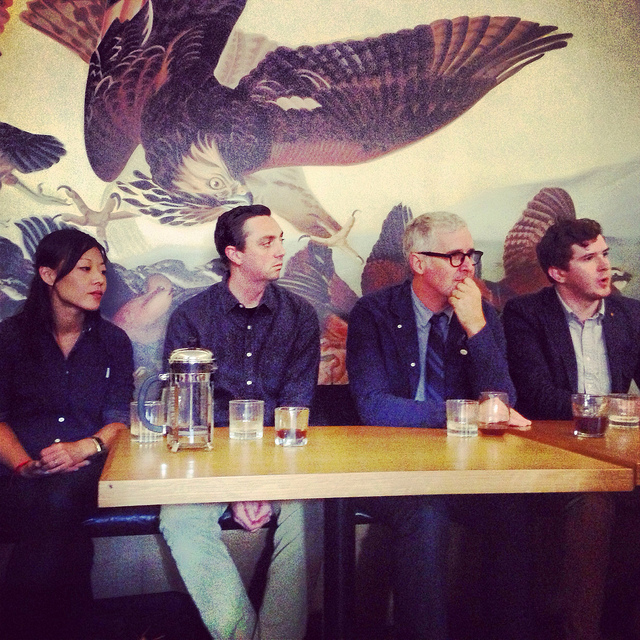
The abundance of café’s around the city is, in our eyes, a good thing. Along with their rise, we’ve seen our to-go-cup of coffee elevated well beyond the local bodega, such that the thought of making a cup of coffee at home seems almost silly. Or does it?
A small, devoted Saturday morning crowd was in Williamsburg for the inaugural weekend session of Taste Talks, a conference put together by Northside Media Group, and curated by Chef April Bloomfield. The session at hand was to discuss the art of home brewing. The panel included some of the big names in coffee with a local presence in New York City: Intelligentsia, which began in Chicago; Blue Bottle, who started out of a garage in San Francisco; Stumptown, which was launched first in Portland; and Toby’s Estate, the farthest afield, which began in Australia.
The four panelists each pointed out what tools were used at their local café’s, focusing on drip coffee, as well as the benefits from tasting coffee in multiple ways. James Freeman, the founder of Blue Bottle, pointed out that most “people make coffee every day of their life.” When you think of it like that, why not put a culinary passion into what we do in our own kitchen?
Placed at each of our tables were different coffee contraptions: the Chemex, AeroPress, French Press, Hario V60 and more. Before we could wonder if we would be rolling up our sleeves, Liz Clayton, our moderator, kicked off the discussion with this question: who thought they made good coffee at home? Not many hands were raised. With so many stellar options available, do we need to know how to make a good cup of coffee? And, what exactly goes into it?
While we sipped on a Stumptown brew of Ethiopian beans prepared in a Chemex (which is also the only device found in the permanent collection of the MOMA), the panelists discussed when they started to seek more than just diner coffee. Allie Caran, from Toby’s, pointed out that, maybe twenty years ago, the French press, that ubiquitous glass jar with the silver plunge, was how many people got their first start in home brewing. Since that time, and as the commercially available beans began to improve, so did the options for brewing. Nick Kirby, from Stumptown, was the first to mention that, at the beginning of coffee culture, people weren’t “used to coffee tasting this good.”
Here are some home options, if you’re ready to ditch your Mr. Coffee:
The Aeropress: Designed by inventor Alan Adler of the Aerobie, this easy to clean and use device has been perfected for lower acidity at espresso strength. Total brewing takes 30 seconds. It also costs less than $30. More than a device, it’s a community with international Aeropress competitions.
The Chemex: a glass beaker with a narrow waist that is hand blown in Western Massachusetts. The panel noted that the Chemex may be one of the hardest to learn and least forgiving of the available options, but it also serves coffee with the greatest clarity of taste, so sweet you don’t need sugar.
The Hario V60: a ceramic cone for a pourover, which our experts say is the most precise home option but also the most difficult to learn, due to the giant center hole in the base, making it the least forgiving. Marty Sweeney from Intelligentsia noted that the V60 is better for batch brewing.
The Bee House: a ceramic cone with a wedge shaped base. It has two small holes in the bottom for a pourover that the experts say is a little more forgiving, because the smallness of the holes forces the user to pour the water in with patience.
The French Press: a glass jar with a mesh screen that requires coarsely ground coffee (so it doesn’t permeate the screen). The press offers a much bolder coffee taste with a high amount of body. Some even say a press produces a creamier coffee. But you won’t taste many of the flavor notes because it’s too bold and full.
The panelists all agreed that to make a truly good coffee you’ll need a scale to weigh your beans. Kirby added that gaining “a command of the variables,” areas like water temperature, brew ration and grind size, was crucial.
Are you ready to elevate your coffee craft? Each of the companies offer tasting opportunities, lessons and answers for the coffee curious. Stumptown has two locations, on W. 29th Street and W. 8th Street. Intelligentsia can be found nestled inside The High Line Hotel. Blue Bottle is on Berry Street in Williamsburg with four additional locations in Manhattan. Toby’s Estate is on North 6th Street, also in Williamsburg. We’re surrounded by the best coffee in the world, grab some beans and get to brewing.
Check out our list of Top 10 Coffee Shops in Manhattan for design buffs too.





